TP-Link
Archer
BE3600:
30-second
review
With
many
businesses
and
home
users
not
fully
exploiting
Wi-Fi
6E
technology,
the
shark-like
need
for
the
comms
industry
to
keep
moving
forward
has
spawned
Wi-Fi
7
hardware.
However,
with
budgets
being
tight
many
have
questioned
the
balance
of
performance
benefits
over
cost
in
the
deployment
of
Wi-Fi
7.
The
TP-Link
Archer
BE3600
(aka
Archer
BE230)
aims
to
burst
that
bubble
with
a
Wi-Fi
7
capable
router,
suitable
for
fibre
and
ADSL
broadband,
arriving
at
the
shockingly
low
price
of
$120
in
the
USA.
When
you
consider
that
a
typical
Wi-Fi
7
router
starts
at
$400
and
can
be
much
more
expensive,
that
begs
the
question:
What
did
TP-Link
leave
out
of
the
BE3600
to
achieve
that
price
point?
For
starters,
this
is
just
a
dual-band
2×2
router
with
a
bandwidth
of
2882
Mbps
on
5GHz
and
688
Mbps
on
2.4GHz,
giving
it
an
AX3600
rating.
That’s
not
a
huge
amount
of
bandwidth,
and
older
hardware
can
offer
more
with
triple-
or
quad-band
configurations.
It
also
lacks
the
6GHz
channel,
making
this
a
Wi-Fi
7
router
only
because
that
isn’t
a
prerequisite
of
the
spec.
On
that
basis,
the
temptation
is
to
think
of
the
BE2600
as
being
Wi-Fi
in
name
only,
but
that’s
not
entirely
fair.
This
router
has
one
feature
that
most
Wi-Fi
6
routers
do
not
have
–
two
2.5GbE
LAN
ports.
With
broadband
now
being
offered
at
greater
than
Gigabit
speeds,
the
ability
to
connect
to
a
fibre
modem
at
2.5GbE
and
connect
the
local
network’s
wired
infrastructure
at
that
speed
is
significant.
Making
it
easily
worth
the
asking
price.
That
one
trick
makes
the
BE3600
worthy
of
consideration,
even
if
you
don’t
use
the
Wi-Fi
functionality
and
simply
make
it
an
internet-connected
router.
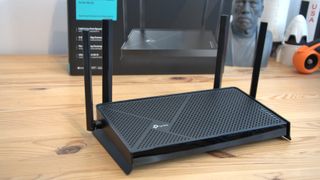
(Image
credit:
Mark
Pickavance)
TP-Link
Archer
BE3600:
Price
and
availability
-
How
much
does
it
cost? £120/$99 -
When
is
it
out? Available
now -
Where
can
you
get
it? You
can
get
it
from
Amazon
and
many
other
online
retailers.
TP-Link
hardware
is
well
distributed,
enabling
most
locations
to
find
it
through
Amazon
or
other
online
retailers.
One
slight
oddity
about
this
design
is
that
TP-Link
sells
it
as
the
BE3600
reviewed
here,
as
well
as
the
Archer
BE230.
To
underline
that
point,
the
router
was
identified
as
the
BE230
when
it
was
configured
using
the
TP-Link
Tether
mobile
app.
Other
versions
of
this
hardware
made
specifically
for
the
Chinese
market
are
available
on
AliExpress.
These
are
dramatically
cheaper,
like
$35,
but
we
can’t
guarantee
their
specifications
or
that
they
have
firmware
designed
for
use
outside
China.
The
best
price
for
US
customers
is
Walmart,
which
has
this
router
for
just
$99!
Overall,
for
the
features
provided,
the
asking
price
is
remarkably
competitive.

(Image
credit:
Mark
Pickavance)
-
Value
score:
4/5
TP-Link
Archer
BE3600:
Specs
to
scroll
horizontally
| Feature | Spec |
|---|---|
| Model: |
TP-Link BE3600 (aka BE230) |
| 2.4GHz: |
2×2 up to 688Mbps (20/40MHz) |
| 5GHz: |
2×2 up to 2882Mbps (20/40/80/160MHz) |
| 6GHz: | N/A |
| Ports: |
1x 2.5GbE WAN1x 2.5GbE LAN3x 1GbE LAN1 x USB 3.0 1 x Reset button |
| Mesh: | EasyMesh |
| MLO | Yes |
| AFC | No |
|
Link Aggregation | No |
| Modes |
Router Mode Access Point Mode |
| Firmware: |
1.1.9 Build 20240729 ref. 16363 |
| Dimensions: |
272.7 x 147 x 41.7mm |
| Weight: | 550g |
TP-Link
Archer
BE3600:
Design
-
Cheaply
made -
Simple
to
deploy -
2.5GbE
is
the
future
The
case
of
the
Archer
BE3600
is
common
to
several
TP-Link
routers,
including
the
Archer
BE6500,
which
has
identical
aesthetics
other
than
having
six
antennae.
It’s
a
black
plastic
box
where
manufacturing
cost
consideration
was
evidently
paramount.
The
LED
lights
are
visible
through
a
line
of
holes
on
the
right-hand
front
side,
and
all
the
ports
are
on
the
rear
edge.
It
comes
with
the
four
attached
antennae,
though
these
can
be
unscrewed
and
replaced
with
others
if
you
want
to
make
those
adjustments.
On
the
back
of
the
router
is
the
inlet
for
the
12v
1.5A
power
supply,
a
single
USB
3.0
port,
four
LAN
ports,
one
WAN
port,
buttons
for
WPS,
LEDs,
a
disabling
Wi-Fi
button,
and
a
reset
hole.
The
blue
WAN
port
is
2.5GbE,
enabling
this
router
to
connect
to
a
better-than-gigabit
Ethernet
broadband
service.
The
first
LAN
port
is
also
this
specification,
enabling
better-than-gigabit
broadband
to
be
distributed
through
the
wired
network
if
you
have
2.5GbE
switches.
With
some
fibre
providers
now
offering
2.2GbE
internet
connections,
this
is
exactly
the
hardware
needed
to
exploit
it.
Over
Wi-Fi,
exploiting
a
connection
like
that
requires
Multi-Link
Operation
(MLO)
on
the
connecting
device,
as
the
router
doesn’t
support
6GHz.
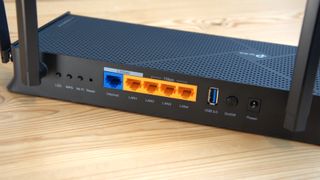
(Image
credit:
Mark
Pickavance)
TP-Link
didn’t
provide
information
about
the
internal
platform
other
than
that
it’s
a
quad-core
SoC
running
at
2GHz.
Past
experience
tells
us
that
it’s
probably
a
decent
Qualcomm-made
SoC
chosen
for
minimal
power
consumption
and
heat
generation,
and
it’s
not
an
old
Chinese
SoC
offloaded
on
TP-Link.
There
is
no
active
fan,
and
all
cooling
is
through
the
passive
transit
of
air
through
the
vented
top
and
underside.
The
router
can
be
wall-mounted,
but
TP-Link
didn’t
include
any
screws
for
this
purpose.
All
that
comes
with
the
router
is
a
single
high-quality
Ethernet
cable
and
the
wall-socket
12V
PSU.
Overall,
the
BE3600
was
built
for
a
low
price
and
lacked
the
robustness
of
more
expensive
designs.
But
unless
it
is
needed
to
operate
in
an
industrial
environment
and
not
an
office
or
home,
then
it
probably
is
good
enough
for
the
two
years
of
warranty
that
TP-Link
offers.

(Image
credit:
TP-Link)
Design
score:
3/5
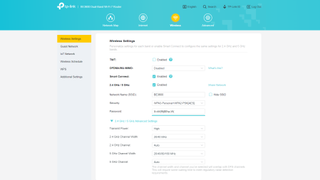
(Image
credit:
Mark
Pickavance)
TP-Link
Archer
BE3600:
In
use
-
Web
or
phone
app
interface -
No
bridging
or
link
aggregation -
Decent
performance
There
are
many
possible
paths
to
get
the
Archer
BE3600
operational,
but
the
easiest
method
is
to
use
the
TP-Link
mobile
Tether
application.
However,
we
had
some
slight
issues
with
that
approach
when
we
wanted
to
add
the
router
alongside
other
hardware
sharing
the
same
SSID.
In
this
scenario,
it’s
best
to
let
the
router
have
a
unique
SSID,
and
then,
when
it
is
fully
identified
and
configured,
you
can
flip
the
SID
back
to
the
common
one.
This
router
only
supports
modes
that
make
it
the
Internet-connected
router
or
an
Access
Point.
It
has
no
repeater
or
bridge
modes,
and
the
LAN
ports
don’t
support
link
aggregation.
There
are
also
no
special
gaming
features
to
reduce
lag
for
specific
connections,
and
while
the
Smart
Home
functionality
offers
IFTTT
and
Alexa,
it
doesn’t
specifically
recognise
Google
Home
technology.
What
is
useful
is
that
by
default,
the
system
defines
an
IOT
(Internet
of
Things)
SSID
that
encourages
those
using
Home
Assistant
or
similar
to
isolate
the
smart
devices
from
the
normal
wireless
traffic
and
equipment.
The
web
interface
will
be
familiar
to
anybody
who
has
used
TP-Link
routers
in
the
past
few
years,
and
it
provides
a
procedural
approach
to
the
features
and
functionality.
What’s
important
to
realise
with
this
hardware
is
that
some
of
the
best
features
are
set
to
off
by
default,
since
many
owners
won’t
need
them.
A
classic
example
of
this
is
Multi-Link
Operation
(MLO),
a
facility
that
appeared
with
Wi-Fi
7
that
allows
multiple
bands
to
be
aggregated
to
provide
both
higher
speeds
and
reliability.
If
you
don’t
have
Wi-Fi
7
devices
or
adapters,
and
they
are
thin
on
the
ground,
then
there
is
no
point
turning
this
feature
on.
And
even
if
you
do,
but
the
Internet
connection
is
below
a
gigabit,
it
wouldn’t
provide
much
advantage
unless
you
are
connecting
to
local
servers.
In
our
test
environment,
we
have
a
910mb
broadband
connection
and
were
able
to
get
full
speed
from
5GHz
connections
with
the
BE3600
easily,
at
short
range.
With
the
potential
for
2882
Mbps
over
5GHz,
that’s
more
than
most
operations
have
unless
they’re
bonding
multiple
services
together.,
MLO
would
be
advantageous
if
you
have
even
faster
speeds
than
2882
Mbps
where
the
bandwidth
in
5GHz
isn’t
enough
to
saturate
the
connection.
One
caveat
to
the
MLO
implementation
here
is
that
it
typically
merges
the
2.4GHz,
5GHz,
and
6GHz
channels
for
maximum
coverage,
but
this
router
doesn’t
have
the
6GHz
band
and
can
only
merge
the
two
lesser
bands.
That
omission
also
means
it
doesn’t
support
Automated
Frequency
Coordination.
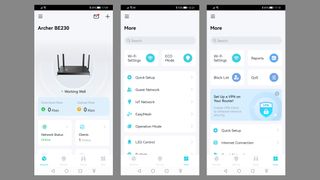
(Image
credit:
Mark
Pickavance)
Comparing
the
BE3600
with
other
Wi-Fi
7
routers,
most
of
which
are
disturbingly
expensive,
this
isn’t
the
fastest
we’ve
seen,
but
it’s
far
from
the
slowest.
Connections
were
rock
solid
until
the
signal
started
to
degrade
due
to
multiple
walls
or
extreme
range.
It
goes
without
saying
that
wireless
networking
benchmarking
is
a
rabbit
hole
of
infinite
depth,
which
guarantees
almost
nothing
about
how
the
hardware
will
perform
when
connected
to
your
network
and
broadband.
The
BE3600
worked
well
in
our
router-busy
network
environment
but
might
perform
differently
elsewhere.
Also,
being
so
cheap,
the
BE3600
has
some
limitations
that
more
expensive
routers
don’t
often
have.
With
only
a
2×2
antenna
configuration,
the
issue
with
this
hardware
is
mostly
about
how
many
simultaneous
connections
it
could
reasonably
support
compared
to
a
4×4
arrangement.
Because
it
doesn’t
have
6GHz,
and
therefore
a
dedicated
backhaul,
mesh
on
this
system
isn’t
ideal
unless
you
run
Ethernet
cables
to
link
the
routers
together.
One
aspect
that
we’re
not
fans
of
is
that
the
router
has
a
basic
security
protection
and
family
admin
model,
but
you
are
encouraged
to
upgrade
this
to
get
advanced
parental
controls
and
even
more
protection.
Sadly,
TP-Link
would
like
a
monthly
subscription
for
the
full
security
experience.
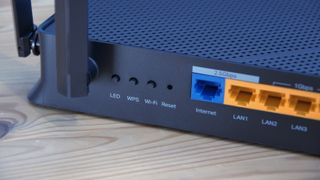
(Image
credit:
Mark
Pickavance)
-
In
Use:
3.5/5
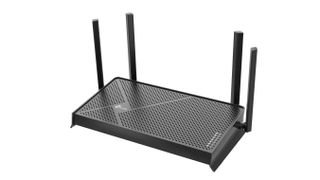
(Image
credit:
TP-Link)
TP-Link
Archer
BE3600:
Verdict
It’s
remarkable
how
cheaply
TP-Link
can
make
the
BE3600
and
still
make
a
profit,
but
it
probably
helps
that
this
device
doesn’t
offer
6GHz
and
is
made
entirely
of
plastic.
The
logic
of
why
it
exists
is
predicated
on
the
lack
of
agreed
6GHz
standards
in
China,
resulting
in
Wi-Fi
7
products
like
the
BE3600
appearing
that
don’t
have
that
piece
of
the
Wi-Fi
jigsaw.
For
Western
countries
with
6GHz
standards,
this
might
be
considered
less
than
genuine
Wi-Fi
7,
but
this
router
offers
the
2.5GbE
LAN
ports
that
make
it
incredibly
useful
even
without
the
6GHz
band.
In
a
nutshell,
that’s
why
you
should
buy
this
router
rather
than
the
full
Wi-Fi
7
experience,
which
typically
starts
at
around
$400.
If
you
want
Wireless
bandwidth
to
burn
or
dedicated
mesh
backhaul
channels,
then
look
elsewhere.
But
if
you
need
to
distribute
better-than-gigabit
broadband,
then
the
BE3600
just
walked
through
the
door.
Should
I
buy
a
TP-Link
Archer
BE3600?
to
scroll
horizontally
| Attributes | Notes | Rating |
|---|---|---|
| Value |
Amazing value for money | 4/5 |
| Design |
Simple, but entirely made of plastic. | 4/5 |
|
In Use |
It’s not the fastest Wireless networking around, but the wired networking makes up for it. | 3.5/5 |
| Overall |
Cheap, and has limits, but fewer than the price might suggest. | 4/5 |
Buy
it
if…
Don’t
buy
it
if…
Didn’t
find
what
you
wanted?
Check
out
our
selection
of
the
best
business
routers
